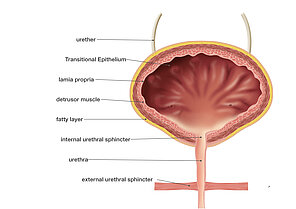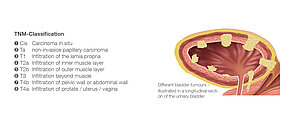
Bladder cancer
What is bladder cancer?
Bladder cancer is a malignant disease of the urinary bladder. For a better understanding we want to have a brief look into function and structure of a healthy bladder, first.
The urinary bladder
The urinary bladder
 Urine is produced in the kidneys and transported through two tubes (called ureters) to the urinary bladder. There, the urine is collected and released bulk wise from the body. In order to fulfil this task, the bladder consists of muscular walls forming a flexible balloon embedded in the pelvis. A healthy adult bladder has a capacity of 300-350 ml.
Urine is produced in the kidneys and transported through two tubes (called ureters) to the urinary bladder. There, the urine is collected and released bulk wise from the body. In order to fulfil this task, the bladder consists of muscular walls forming a flexible balloon embedded in the pelvis. A healthy adult bladder has a capacity of 300-350 ml.
During urination, urine is pushed out of the bladder through the urethra by detrusor muscle contraction and opening of the urinary sphincter. The principle is similar to an inflated balloon loosing air when the vent is opened. In women, the urethra opens in front of the vagina and is much shorter than in men, where it passes through the prostate gland and opens at the tip of the penis.
The bladder wall consists of 4 main layers:
- The inner lining is called the urothelium. It consists of cells called urothelial or transitional cells.
- Next to the urothelium lies the lamia propria, a thin layer of blood vessels and nerves embedded in connective tissue.
- A thick muscle layer, the muscularis propria, is enclosing these two inner layers.
- On the outer side, the bladder is separated from nearby organs by a fatty layer.
These layers play an important role in growth of bladder cancer. Most bladder cancers start in the urothelium. If untreated, the cancer typically grows into deeper layers and eventually through the bladder and into surrounding tissues. With progressing cancer advance it becomes harder to treat.
Types of bladder cancer
Types of bladder cancer

There are several types of bladder cancer. They are identified by their cellular origin, which is done by microscopic examination of tumour tissue samples. This discrimination is important, as different cancer types show different pathological behaviour and need to be treated differently.
Transitional cell (urothelial) carcinoma
Covering more than 90% of diagnosed bladder cancers, transitional cell carcinoma (TCC) is by far the most common subtype. TCC cells develop from urothelial cells on the inside of the bladder and look accordingly under the pathologist’s microscope.
A big part of the urinary tract is lined by urothelial cells, starting from the renal pelvis, through the ureters, the actual urinary bladder and finally the urethra. Therefore, TCCs can occur in all these placers, not only the bladder. This means, that the complete urinary tract needs to be checked in case of bladder cancer. As the inner bladder surface covers the largest area within the urinary tract and has the longest exposure time to urine, containing carcinogenic substances, like degradation products from cigarette smoke, TCC shows up in the bladder, in most of the cases, nonetheless.
For prognosis and treatment, urothelial carcinomas are divided into two states, depending on how far they have invaded into the bladder wall:
- Non-muscle-invasive bladder cancers are superficial cancers of the transitional epithelium and those which have not grown beyond the lamina propria. The tumour can be surgically removed in this stage, although recurrences are frequent.
- Muscle-invasive bladder cancers have grown into the muscle layer of the bladder or even beyond and are more likely to spread. In this stage, they are harder to treat, including bladder removal and systemic chemotherapy.
A further division into TCC subtypes can be done according to the growth pattern of the tumour:
- Papillary tumours grow coral-like from the inner bladder surface. Low grade papillary tumours often grow toward the centre of the bladder without invading deeper tissue layers. In this case, they tend to have a good outcome.
- Flat carcinomas (Carcinoma in situ / CIS) don’t project into the hollow bladder but grow evenly within the inner layer of urothelial cells.
Other types of bladder cancer
There are also other less common cancer types that can start in the bladder:
Squamous cell carcinoma: In Europe, only about 1% to 2% of bladder cancers are squamous cell carcinomas. Under a microscope, the cells look much like the flat cells that are found on the surface of the skin. Nearly all squamous cell carcinomas are invasive.
Adenocarcinoma: Only about 1% of bladder cancers are adenocarcinomas. The cancer cells have a lot in common with gland-forming cells of colon cancers. Nearly all adenocarcinomas of the bladder are invasive.
Small cell carcinoma: Less than 1% of bladder cancers are small-cell carcinomas, which start in nerve-like cells called neuroendocrine cells. These cancers often grow quickly and typically need to be treated with systemic chemotherapy.
Sarcoma: Sarcomas start in the muscle cells of the bladder, but they are rare.
As in most regions of the world transitional cell carcinoma covers the vast majority of all diagnosed bladder cancers, we will focus on this tumour type in the following chapters.